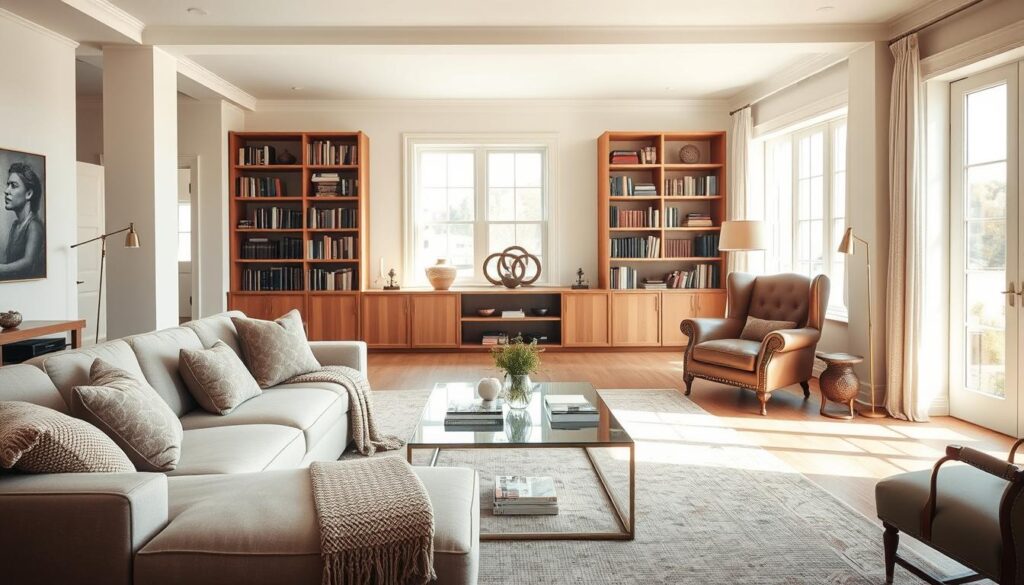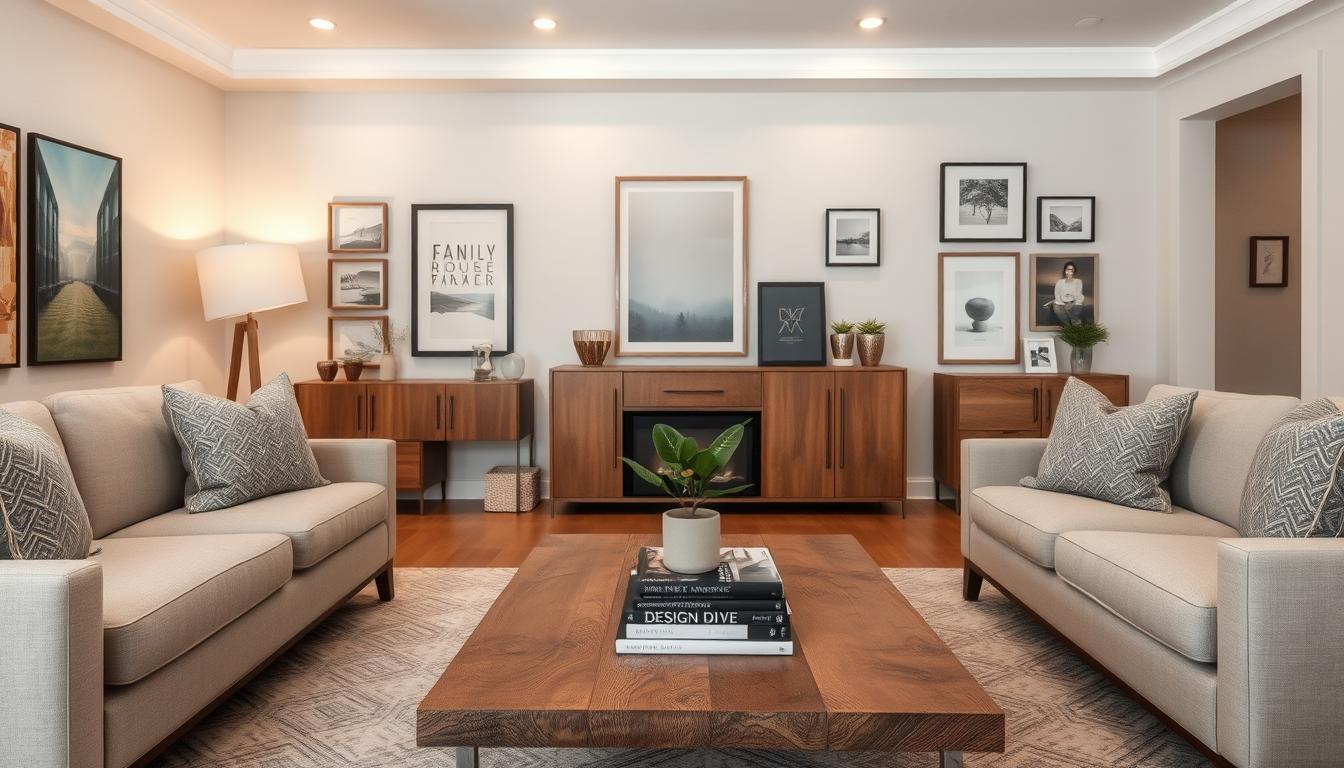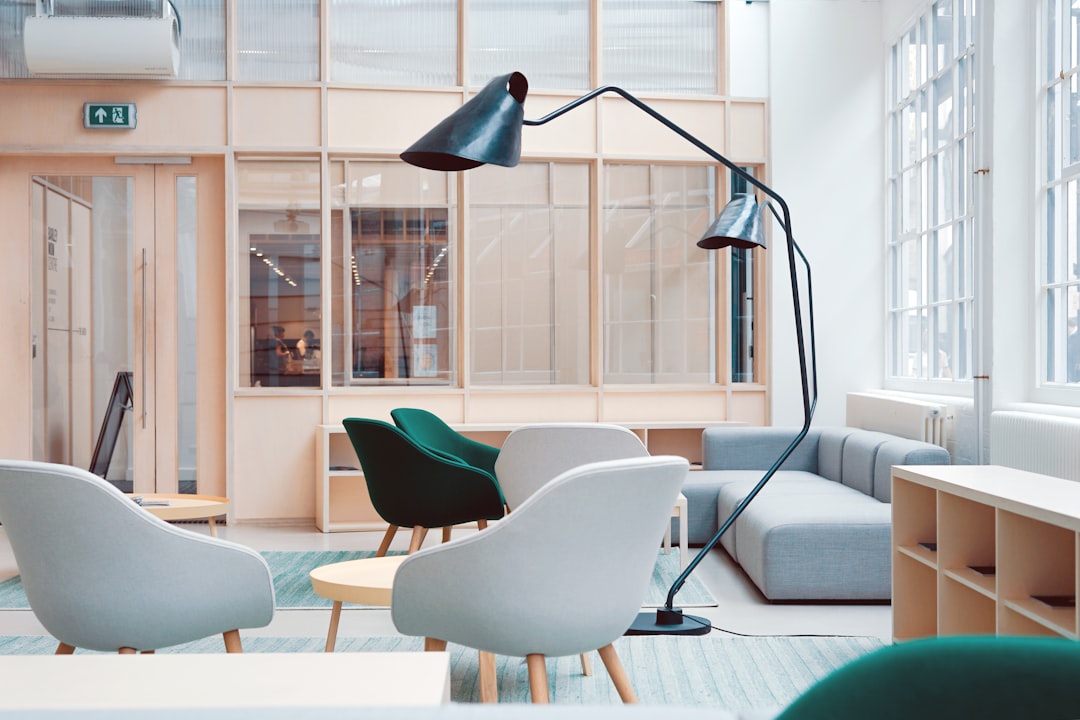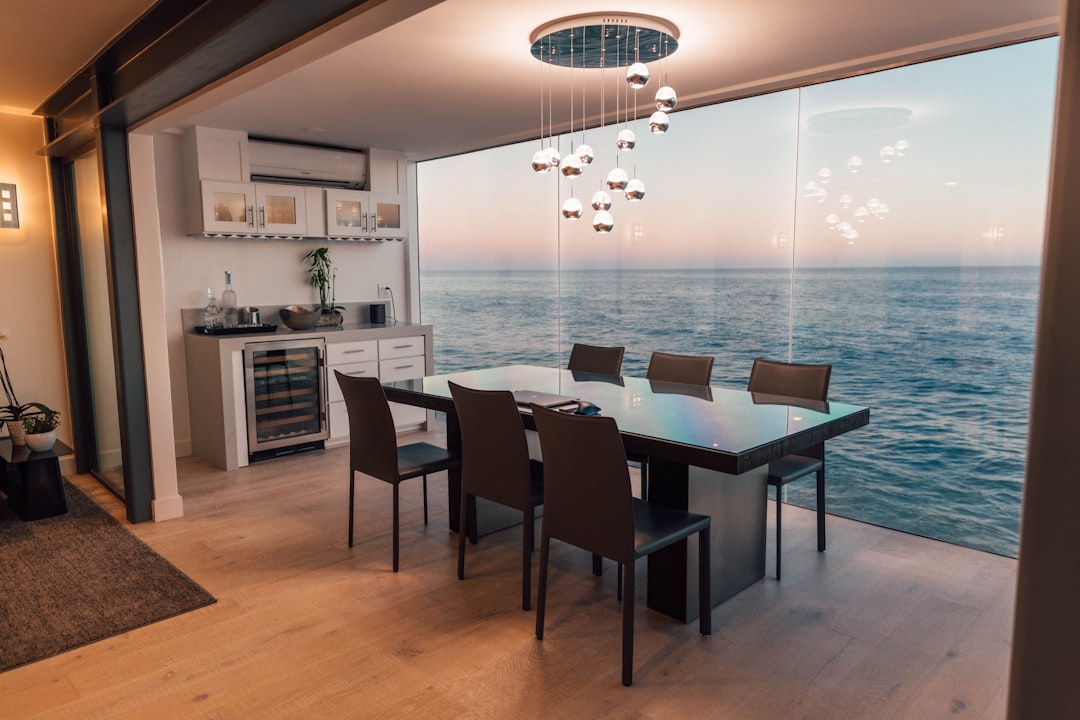Did you know that 63% of homeowners love mixing old and new in their homes? This trend has led to a decorating style that combines traditional and modern looks. It’s called transitional styling, focusing on blending different elements smoothly.
This style mixes the cozy feel of traditional decor with the clean lines of modern home styling. The outcome is a space that feels both classic and fresh.
Key Takeaways
- Transitional style blends traditional and contemporary elements.
- It creates a harmonious and balanced aesthetic in homes.
- This style allows for a mix of old and new decor pieces.
- It’s ideal for those who want a timeless yet modern look.
- Transitional design can be adapted to various spaces within a home.
Understanding Transitional Interior Design
Transitional interior design mixes traditional and modern styles. It’s popular for creating a balanced look that’s both timeless and modern.
Definition and Characteristics
Transitional design blends classic and modern elements. It uses neutral color palettes and clean lines. It also combines traditional and contemporary furniture.
This style avoids too much ornamentation. Yet, it keeps a cozy, inviting feel. For example, a transitional living room might have a contemporary sofa and a traditional coffee table.
Historical Context
Transitional design came about as a middle ground. It evolved from traditional and modern styles. It aims to please various tastes and preferences.
In the late 20th century, it became more popular. Homeowners and designers sought a style that was both elegant and practical. Transitional design combined the warmth of traditional interiors with the simplicity of modern ones.
Importance in Modern Homes
In today’s homes, transitional design is key. It makes spaces both beautiful and functional. It lets homeowners add personal touches, making each space unique.
Transitional design is adaptable to changing lifestyles and tastes. It fits well with new technologies and sustainable materials. It offers a timeless look for modern living.
Key Elements of Transitional Design
Transitional interior design blends styles smoothly. It’s about finding a balance that makes a space feel welcoming and cohesive. This balance is key to creating a harmonious look.
Several elements are at the heart of transitional design. These include a well-chosen color palette, the right furniture, and a mix of textures and materials. Together, they create a space that feels both stylish and inviting.
Color Palette
A good color palette is essential in transitional design. It sets the mood for the whole space. Transitional design often uses a neutral base with warm and cool tones.
Think of combining:
- Soft whites and creams
- Warm beiges and taupes
- Rich grays and blues
These colors help create a calm and serene atmosphere. They provide a versatile background for other design elements.
Furniture Styles
Furniture is crucial in transitional design. It must mix traditional and modern styles. To get a transitional look, look for:
- Furniture with clean lines and little decoration
- Pieces that mix traditional and modern materials, like wood and metal
- Comfortable, inviting upholstery
By combining these, you can achieve a stylish and functional look.
Textiles and Materials
Textiles and materials add depth and interest to transitional design. Mixing textures, like smooth and rough, creates a rich look. Consider using:
- Natural fibers like cotton and linen
- Luxurious fabrics like velvet and silk
- Wood and metal accents
Thoughtfully combining these elements makes a space both beautiful and welcoming.
Creating a Transitional Space
Creating a transitional space means taking a room-by-room approach. This method helps us design each room to fit its purpose. It ensures our home looks cohesive and inviting.
Room-by-Room Approach
The living room is where we relax and socialize. A good transitional design here mixes traditional furniture with modern touches. A neutral color scheme brings it all together.
Choosing furniture that’s both stylish and practical is key. For example, a classic sofa works well with a sleek coffee table. This mix creates an interesting contrast.
Furniture Arrangements
How we arrange furniture is crucial in a transitional space. We aim for a balance between conversation and openness. In a dining room, place the table centrally and use chairs that mix old and new styles.
“Design is not just about making things look pretty; it’s about creating a functional and comfortable space.” A well-planned layout greatly improves a room’s feel.
Accessorizing for Impact
Accessories are vital in a transitional space. We should pick items that enhance the room’s design without overdoing it. A bold color scheme through throw pillows, for example, adds depth and interest.
“The right accessories can elevate a room from ordinary to extraordinary.” –
When accessorizing, think about the look you want to achieve. Mixing textures, colors, and shapes creates a welcoming atmosphere. This reflects the essence of transitional design.
- Select a few statement pieces to anchor the room.
- Use throw pillows and blankets to add color and texture.
- Incorporate natural elements, such as plants or a vase with branches, to bring in a touch of nature.
By following these tips and being thoughtful in our design, we can make a transitional space that’s both beautiful and functional.
Common Misconceptions About Transitional Design
Transitional interior design is often misunderstood. This leads to several misconceptions about its style and use. It’s clear that transitional design mixes traditional and modern elements. This makes it suitable for different tastes and budgets.
A Timeless Style, Not Just a Trend
Many think transitional design is just a trend. But, it has been evolving for decades. It’s a timeless choice for interior styling, blending classic and modern elements.
Key characteristics of transitional design include balanced furniture and a neutral color palette. It also focuses on comfort and functionality.
A Style That Offers Personality
Some believe transitional design lacks personality. But, it actually allows for a lot of personal expression. Homeowners can choose furniture, textiles, and accessories to reflect their unique tastes.
Accessible to All Budgets
Many think transitional design is only for high-end homes. But, it’s actually adaptable to all budgets. Mixing high-end and affordable pieces can create a sophisticated look without spending too much.
For example, a luxury sofa paired with budget-friendly chairs and decor can make a stylish living room. The focus should be on quality over quantity. Invest in pieces that last.
Benefits of Transitional Interior Design
Transitional interior design offers many benefits. It’s versatile and has a timeless appeal. This style blends contemporary and modern elements well, creating a welcoming atmosphere.
Versatility for Different Styles
Transitional design is very versatile. It lets homeowners mix different styles, like modern minimalism and traditional elegance. For example, you can combine a modern sofa with a traditional armchair.
This flexibility makes it easy to update your decor without a full redesign. For inspiration, check out Cozy Nest Plans.
Timeless Appeal
Transitional design is also known for its timeless appeal. It combines classic elements with a modern twist. This ensures your home stays stylish for years.
This quality is great for those who want to invest in their home without worrying about the design becoming outdated.
Encourages Cohesion
Transitional design also promotes cohesion in a space. It balances texture, color, and form. This creates a harmonious environment.
This cohesion is essential for a welcoming and comfortable home. Every element works together in harmony.
In summary, transitional interior design is a great choice for many homeowners. Its versatility, timeless appeal, and ability to create cohesion make it popular. Whether updating a room or redesigning your home, transitional design is a flexible and enduring option.
Transitional Design vs. Other Styles
Transitional design is special because it combines different elements in a way that feels right. It lets homeowners try out various styles, making it a favorite in modern decor.
Comparison with Contemporary Design
Many people mix up transitional and contemporary designs because they share modern traits. But, contemporary design is more about following trends, while transitional design blends old and new. For example, a contemporary room might have sleek furniture, while a transitional one might add traditional fabrics or patterns to it.

Contrast with Traditional Design
Traditional design sticks to classic styles and fancy details. Transitional design, on the other hand, makes these elements simpler and less formal. For instance, a traditional dining room might have fancy moldings and lights, but a transitional one might choose simpler moldings and less flashy lights.
Blending with Minimalism
Minimalism focuses on simplicity and clean lines, which can feel cold. Transitional design, with its warm and inviting elements, can make minimalist spaces feel cozy. This mix creates a calm yet welcoming atmosphere.
| Design Style | Key Characteristics | Transitional Design Comparison |
|---|---|---|
| Contemporary | Modern, trend-driven, often sleek and minimalist | Shares modern elements but balances with traditional aspects |
| Traditional | Classic, ornate, formal | Simplifies traditional elements, making them less formal |
| Minimalism | Simple, clean lines, sometimes cold or sterile | Adds warmth and inviting elements to minimalist spaces |
Knowing how transitional design compares to other styles helps homeowners choose the right decor. This way, they can create spaces that are both stunning and personal.
Sustainable Practices in Transitional Design
Transitional design is all about making choices that are good for the planet. It’s not just a trend; it’s a must for reducing our impact on the environment.
In transitional design, we can be green in many ways. This includes the materials we pick and how we find our furniture. Let’s explore some key areas where we can help.
Eco-Friendly Materials
Choosing eco-friendly materials is a big step towards a greener design. This means using reclaimed wood, paints with low VOCs, and sustainable fabrics.
Bamboo is a great example. It’s renewable and can be used for floors, furniture, and walls. It’s good for the planet and looks great too.
Energy Efficiency Considerations
When we renovate, thinking about energy is key. We can use LED lights, which use less power than old lights. We should also pick appliances that save energy.
Letting in natural light is another smart move. It cuts down on the need for artificial light. We can do this by placing mirrors, using light curtains, and keeping windows clear.
Sourcing Local Elements
Buying local is another way to be green. It cuts down on emissions and helps local businesses.
For example, choosing countertops from nearby quarries is a good choice. It’s better for the planet and adds a local touch to our designs.
| Sustainable Practice | Benefit | Example |
|---|---|---|
| Eco-Friendly Materials | Reduces environmental impact | Reclaimed wood furniture |
| Energy Efficiency | Saves energy, reduces bills | LED lighting |
| Sourcing Locally | Supports local economy, reduces emissions | Locally sourced granite countertops |
By using these green practices in our designs, we help the planet. We also create spaces that are both lovely and useful.
Trends Influencing Transitional Design Today
In the world of transitional design, new trends are changing how we see color schemes and interior styling. These changes are important as they shape the homes we live in.
Transitional design mixes old and new styles. It’s influenced by trends like using technology, adding natural elements, and open concept living. Let’s explore how these trends affect transitional design.
Use of Technology
Technology is playing a big role in interior design, including transitional spaces. It’s about adding smart home devices and energy-saving lights. These features make our homes more comfortable and efficient.
For example, smart thermostats and lights can be controlled from anywhere. This makes life easier and helps us live greener.
Incorporating Natural Elements
Bringing nature inside is a big trend in transitional design. It uses materials like wood, stone, and plants. This creates a peaceful and natural feel.
Using natural elements adds depth and beauty to a room. A living wall or big plant can also improve air quality. It makes a room feel special.
Open Concept Living
Open concept living is a favorite trend in transitional design. It makes spaces feel bigger and more connected. By removing walls, homes feel more open and flexible.
This style is great for small homes. It makes them feel larger and more useful. It also encourages people to spend time together in the home.
These trends will keep shaping transitional design. By using technology, natural elements, and open spaces, we can make homes that are beautiful, useful, and good for the planet.
Final Thoughts on Embracing Transitional Design
Transitional interior design mixes old and new styles. It creates spaces that are both beautiful and practical. Homeowners can make their homes welcoming and timeless by understanding this design.
Practical Tips for Implementation
To start with transitional design, pick a neutral color scheme. Mix different furniture styles to create a unique look. Remember, it’s okay to try new things and have fun with it.
Collaborating with Professionals
Working with professional interior designers can be very helpful. They guide you through the design process. They also share their expertise to make sure your design comes to life.
Finding Inspiration
For inspiration, check out Houzz, Architectural Digest, and Elle Decor. These sites offer a variety of transitional design styles. They can help spark your creativity as you design your space.



